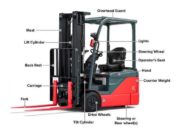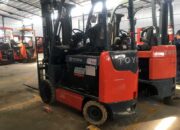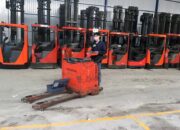Repair and Upgrade of Container Forklift’s Hydraulic Cylinder, and Hydraulic System
Common Malfunctions of Hydraulic Cylinder and System in Container Forklifts Hydraulic cylinders and systems in container forklifts can encounter various issues leading to malfunctions. Below are some examples of common problems and their potential causes:
- Hydraulic oil leakage: This can occur due to cracks, improper sealing, or incorrectly connected parts. Causes may include wear and tear, expired oil lifespan, or the use of unsuitable oil.
- Inability to lift or lower the container: If the forklift cannot lift or lower the container, possible reasons include a faulty hydraulic valve, cracked hydraulic hoses, or a jammed lifting mechanism due to rust or mechanical faults.
- Jerky operation of the system: This may result from a malfunctioning hydraulic pump or valve, insufficient or contaminated hydraulic oil, or mechanical components within the system causing obstruction.
- Low pressure: If the hydraulic system fails to generate enough pressure to lift the container, potential causes could be a weak pump, faulty valve, oil leakage, or inadequate flow.
- Hydraulic pressure loss: If the hydraulic system lacks pressure, the container forklift may struggle to lift or maintain its maximum load capacity.
- Low hydraulic oil level: Insufficient hydraulic oil can lead to high friction within the system, increasing wear and reducing the lifespan of components.
- Cracks and fractures: Cracks on the surface of the hydraulic cylinder or other parts can lead to severe damage and hazards.
- Seal and gasket damage: Damaged seals and gaskets can result in oil leaks, pressure loss, and hydraulic system failures.
- Loss of control: Malfunctions in the control system can lead to an inability to precisely control the lifting and lowering process of the forklift.
- Transmission damage: Any faults in the transmission system can impair the lifting and lowering capabilities.
- Wear or damage to load-bearing components: Load-bearing parts like gears, slide bars, and clamps, if worn or damaged, can weaken the lifting performance.
- Container tilting or skewing during lifting: This could result from improper balance, loose or damaged joints, or exceeding the forklift’s load capacity during transport.
- Noise and vibration: Hydraulic system issues can cause unwanted noise and vibrations. Causes may include faulty valves, improperly functioning hydraulic pumps, or cracked hydraulic hoses.
- Oil leaks at connections: Connections within the hydraulic system, such as hoses, valves, and connectors, can experience oil leakage due to inadequate tightening, cracks, or material defects.
To prevent these issues, regular maintenance and inspections of the hydraulic system are crucial. Technical experts should routinely inspect, maintain, and replace necessary components to ensure safe and efficient operations of container forklifts.
Samco Vina Joint Stock Company specializes in inspecting, repairing, and rectifying damages related to the boom, hydraulic cylinder, and hydraulic system of container forklifts. A Breakthrough in Repair Services and Remedying Hydraulic Cylinder System Malfunctions for Container Forklifts
SamcoVina Joint Stock Company, a leading entity in the field of inspecting, repairing, and rectifying damages related to hydraulic cylinder systems for container forklifts, has officially introduced a unique and high-quality service to meet the increasingly high demands of the market.
With over 10 years of experience in providing and repairing Container forklifts, Samco Vina Joint Stock Company has established a strong presence in providing technical services for container forklifts. Our team of professional and experienced technicians is committed to delivering optimal solutions for customers, ensuring safe operations and maximum efficiency for lifting equipment.
Our prominent services include: Inspection and Analysis: We utilize advanced technologies to inspect and analyze hydraulic cylinder systems, identify the causes of malfunctions, and propose effective solutions.
In-depth Repairs: Our highly skilled technical team performs repairs ranging from minor issues to serious malfunctions, ensuring the smooth and durable operation of hydraulic cylinder systems.
Prompt Troubleshooting: We understand the significance of time in every business operation. Hence, we pledge to provide rapid troubleshooting services, ensuring that customers do not have to wait for an extended period.
Regular Maintenance: We offer regular maintenance services to uphold and extend the lifespan of hydraulic cylinder systems, minimizing the risk of failures and reducing downtime.
Samco Vina Joint Stock Company is committed to delivering utmost customer satisfaction through quality, reliable, and effective repair services. We take pride in being a trusted partner for businesses operating in the transportation and logistics industry.
SAMCOVINA JOINT STOCK COMPANY 26/11 Binh Duong Boulevard, KP. Trung, Vinh Phu, Thuan An, Binh Duong Hotline: 0907 101 899 Email: info@samcovina.com Website: www.samcovina.com







